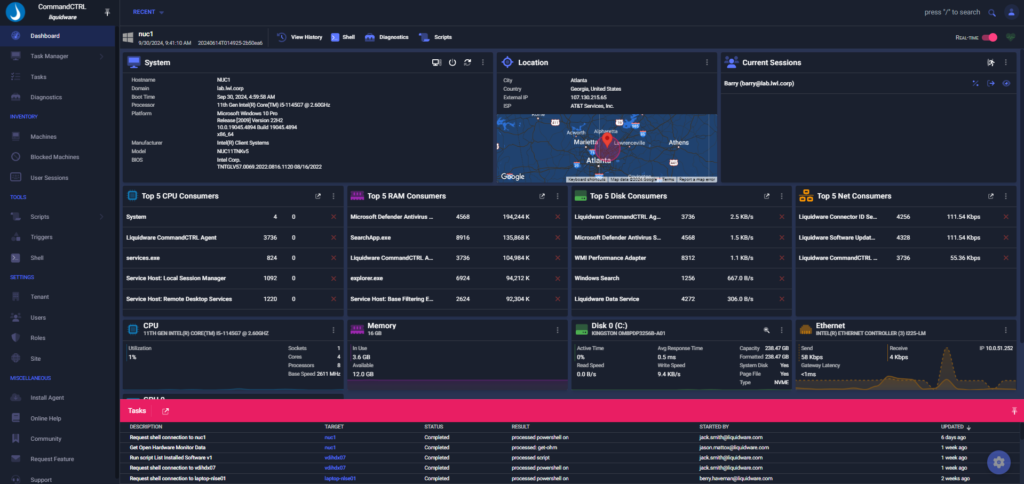
IT environments are constantly being updated, expanded, and optimized. Whether it is adopting new platforms, upgrading infrastructure, or migrating to the cloud, these transitions are often complex and fraught with challenges. The risks are substantial—extended downtime can cripple productivity, compatibility issues can disrupt workflows and maintaining data security becomes increasingly difficult. For IT teams, the pressure is on to ensure that these migrations are executed flawlessly, with minimal impact on the organization’s operations and end-user experience. One of the main issues during a migration is that helpdesk calls spike and CommandCTRL is the perfect solution to reduce those calls.
CommandCTRL is more than just a monitoring tool; it is a comprehensive SaaS remote remediation and support platform that allows IT teams to manage and troubleshoot issues in real-time, no matter where users or devices are located. With CommandCTRL, organizations gain detailed visibility into their IT environments, enabling them to pre-emptively address potential migration challenges. By leveraging CommandCTRL, businesses can navigate the complexities of migrations with confidence, ensuring a smooth transition and minimal disruption to operations.

Understanding the Migration Challenges
Migrations are a fundamental aspect of IT strategy, whether you’re upgrading to a new operating system, transitioning to a cloud environment, or consolidating infrastructure. However, these projects are rarely straightforward and come with a set of unique challenges that can significantly impact both IT teams and end-users. Understanding these challenges is the first step toward a successful migration.
1. Minimizing Downtime and Business Disruption
One of the most pressing concerns during any migration is the potential for downtime. Even brief periods of unavailability can lead to substantial productivity losses, particularly in environments that operate 24/7. For example, if a critical application goes offline during a migration, it could halt operations for entire departments, leading to missed deadlines and frustrated users. The challenge lies in executing the migration quickly and efficiently while ensuring that users have continuous access to the tools they need.
2. Managing Compatibility Issues
Compatibility is another major hurdle during migrations. New systems, applications, or platforms must work seamlessly with existing infrastructure. However, compatibility issues often arise, such as applications that fail to run on a new operating system or integrations that break when moving to a cloud environment. These issues can lead to significant delays and require extensive troubleshooting, which in turn can extend the migration timeline and increase costs.
3. Ensuring Data Integrity and Security
During migrations, data is often moved across different environments, whether from on-premises servers to the cloud or from one system to another. Ensuring that this data remains intact, secure, and accessible throughout the migration process is a complex task. There is always the risk of data loss, corruption, or unauthorized access during the transfer. Additionally, maintaining compliance with data protection regulations adds another layer of complexity, especially when dealing with sensitive or regulated data.
4. Coordinating Across Multiple Teams and Systems
Large-scale migrations often involve multiple teams—each responsible for various aspects of the IT infrastructure. Coordinating these teams to work in sync can be challenging, particularly when managing dependencies across various systems. Miscommunication or misalignment between teams can lead to delays, errors, and rework, further complicating the migration process. Effective coordination is crucial to ensuring that all moving parts come together seamlessly.
5. Handling User Training and Adaptation
Even when a migration is technically successful, the human element cannot be overlooked. Users may need to learn new systems or adapt to changes in how they access their tools and data. Without proper training and support, this adaptation period can lead to frustration, reduced productivity, and an increase in helpdesk tickets. IT teams must prepare for this transition by providing adequate resources and support to help users adapt smoothly to the new environment.
6. Controlling Costs and Resources
Migrations can be resource-intensive, requiring considerable time, manpower, and financial investment. Unforeseen issues like extended downtime, unexpected compatibility challenges, or additional security measures can quickly inflate the cost of the project. IT leaders are often tasked with balancing the need for a smooth migration with the constraints of limited budgets and resources, making cost management a critical aspect of the migration process.
Why CommandCTRL is Essential for Migrations
To address these challenges, CommandCTRL offers a robust solution for handling migrations with a hands-on, white-glove approach. Its real-time monitoring, diagnostic capabilities, and secure support enable IT teams to proactively resolve issues, ensuring a smooth and efficient migration experience. This personalized, responsive approach is vital during migration processes, where user productivity and system performance are paramount. CommandCTRL’s ability to immediately address incidents and optimize workspace performance lays a solid foundation for the broader migration strategy, setting the stage for a seamless transition to enhanced desktop environments. CommandCTRL does this all with:
Real-Time Monitoring and Support
Migrations often introduce unexpected challenges. With CommandCTRL, administrators can monitor the migration process in real-time, identifying and addressing issues as they arise, securely, whether locally or remotely.
Secure Remote Assistance
CommandCTRL offers secure remote shell access, allowing IT professionals to troubleshoot and resolve issues directly on the user’s device. This feature is essential for migrations, where quick intervention can prevent delays.
Shadowing and Guiding Users
CommandCTRL enables administrators to “shadow” users, watching their screens and guiding them through any challenges they encounter during the migration process. This hands-on approach ensures users feel supported and reduces the likelihood of errors.
Non-Intrusive Support
One of the key benefits of CommandCTRL is its ability to give support without disrupting the user. IT admins can perform diagnostics and remediation in the background, ensuring the user can continue working without interruption.
Role-Based Access Control (RBAC)
CommandCTRL’s extensive role-based access allows multiple administrators to join in the migration process. Each admin can be assigned specific roles, ensuring a coordinated and secure approach to migration support.
Building on the capabilities of CommandCTRL, Liquidware’s Stratusphere UX and ProfileUnity further enrich the migration strategy by providing critical insights and comprehensive user management. Stratusphere UX extends the real-time monitoring strengths of CommandCTRL with deep analytics and baseline assessments, helping teams understand current performance and user experience before migration. This ensures that the planned environment is fully compatible and optimized, reducing risks and enhancing the overall user experience. ProfileUnity takes it a step further by managing and migrating user profiles with zero downtime, maintaining continuity across physical, virtual, and cloud environments. Together, these solutions create a powerful synergy that not only addresses immediate migration needs, but also sets up the organization for long-term success with optimized, secure, and user-focused workspaces .
Check out how CommandCTRL can ease those migration worries by taking a trial










Leave A Comment
You must be logged in to post a comment.